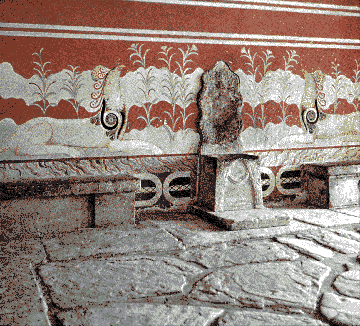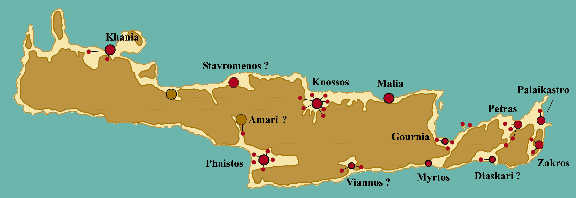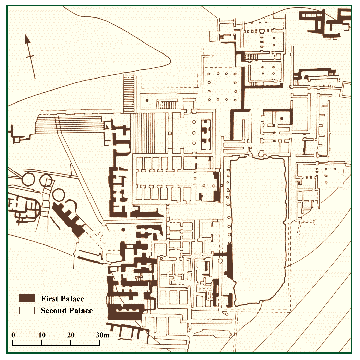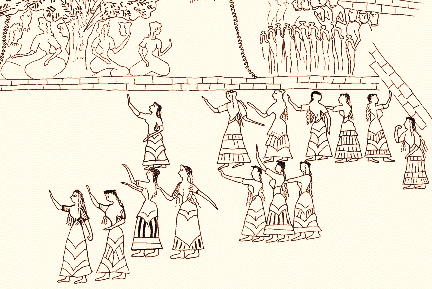|
Jan Driessen Université Catholique de Louvain
The Palace
of Minos? Even before the monumental court complex at Knossos was actually
excavated, Kalokairinos, Schliemann and indeed, Evans himself, had already
identified the visible ruins as a "palace," the abode of a king. The unearthing
of a fine gypsum throne (fig.1) in the West Wing of the building during the
first year's campaign, in 1900, reinforced this view, and mythical Minos
rapidly acquired historical status as the Great King of Crete, as reflected
in the title of Evans' monumental publication, The Palace of Minos at Knossos
(1918-1935). Based on his findings at Knossos, with the legend of Minos at
its interpretative core, Evans attempted a reconstruction of the prehistoric
Cretan political landscape  as a kingdom based on a hereditary monarchy. The
uniformity in material culture, and especially the widespread diffusion of
Linear A - the as yet undeciphered Minoan script used at the time - suggested
to him some central organization and administration and a unified state covering
the entire island during the Neopalatial period, especially in Late Minoan
I (around 1600-1450 BC, according to the traditional chronology). as a kingdom based on a hereditary monarchy. The
uniformity in material culture, and especially the widespread diffusion of
Linear A - the as yet undeciphered Minoan script used at the time - suggested
to him some central organization and administration and a unified state covering
the entire island during the Neopalatial period, especially in Late Minoan
I (around 1600-1450 BC, according to the traditional chronology).
Fig.1: The so-called "Throne Room" in the West Wing of the Palace
of Knossos (photo: J. Driessen)
The discovery of similar court complexes, first at Phaistos (1901), and later
at Gournia (1907), Malia (1915), and Zakros (1963) imposed some modifications
on this way of thinking about palace functions - were these summer residences
for the Knossian Minos or the seats of dependent provincial governors? Further
advances in material culture studies seemed to indicate that during the Middle
Minoan or Protopalatial period (ca. 2000-1750 BC) Knossos was more at an
economic par with the other centers. This suggested a political landscape
of more or less equally independent polities until the Neopalatial period,
when Knossos would have annexed, by force or goodwill, the other regions
of the island. This remained the historical framework up to the end of the
eighties. The nineties, however, witnessed the discovery of yet another series
of court complexes, varying in size but all of clearly monumental character,
at Kommos, Petras, and Galatas, with the strong possibility of many others
existing at Khania, Arkhanes, Stavromenos, Palaikastro, and Protoria, to
name just a few. A quick glance at the map of Crete (fig.2) highlights the
proximity and density of such public buildings, making it more than obvious
that the time is ripe to reconsider the evidence for the Minoan political
situation on the one hand, and the interpretation of the function of these
"palaces" on the other hand.
What kind
of state did the Minoans develop and cherish before mainland Mycenaeans
established themselves on the island after about 1500 BC, bringing with them
a hereditary kingship known as the "wanaks" - a word still used by Homer
some 750 years later? From the start, Evans believed that Knossos was governed
by a Priest-King. In the first volume of The Palace of Minos, he drew attention
to the relief figure in the south wing of the palace (fig.3), and imagined
the ruler seated in the Throne Room flanked by the fresco of griffins (fig.1). Fig.2: Map with locations of sites mentioned in the text.
Includes major Late Minoan I settlements (red dots) and secondary settlements
(orange) (J. Driessen).
The truth is that we still do not know who was physically in charge of Minoan
society. Iconography and texts should be of help, but resist straightforward
interpretation. What is clear is that no figural representations of, or textual
references to, specific rulers exist, nor are there any explicit references
to ruling dynasties. Granted, the bull has been regarded as a symbol for
Knossian power, whereas the so-called Minoan Genius - a modified version
of the Egyptian Tawaret figure - occurs more frequently at Malia. "Possibly"
human figures - often male - are much more prominently represented in Minoan
iconography during the mature Neopalatial period, after the Santorini eruption
(around 1530 BC according to traditional chronology) had affected the core
of Minoan society (Driessen and Macdonald 1997).
And so it seems
possible that, alongside other societal changes that occurred on the island
as a reaction to this natural catastrophe, certain individuals with considerable
charisma, and personal, political, and/or religious power, placed themselves
in the foreground, foreshadowing the introduction of real royalty in the
Late Minoan II period, backed by Mycenaeans.
 This development could be illustrated by several objects that depict male
figures receiving some kind of investiture, often from a prominent female
figure that has been identified as the Mother Goddess. Examples are the
impressions of two gold rings, one known as the "Master Impression" from
Khania, showing a man with an outstretched arm above a fortified coastal
city, the other known as the "Mother of the Mountain" impression from the
palace of Knossos, showing a man with a gesture of devotion in front of a
woman standing on a mountain top, again with an outstretched arm. She is
heraldically flanked by two lions and stands in front of a façade
with sacred symbols. So, in view of later developments it remains a possibility
that some kind of divine or divinely inspired kingship was introduced in
the period between the Santorini disaster and the arrival of the Mycenaeans
two generations later.
This development could be illustrated by several objects that depict male
figures receiving some kind of investiture, often from a prominent female
figure that has been identified as the Mother Goddess. Examples are the
impressions of two gold rings, one known as the "Master Impression" from
Khania, showing a man with an outstretched arm above a fortified coastal
city, the other known as the "Mother of the Mountain" impression from the
palace of Knossos, showing a man with a gesture of devotion in front of a
woman standing on a mountain top, again with an outstretched arm. She is
heraldically flanked by two lions and stands in front of a façade
with sacred symbols. So, in view of later developments it remains a possibility
that some kind of divine or divinely inspired kingship was introduced in
the period between the Santorini disaster and the arrival of the Mycenaeans
two generations later.
[Fig.3: Evans' Priest-King, a relief fresco found in the South Wing
of the Palace of Knossos (photo: S. Sheratt, Oxford, Ashmolean Museum).]
There is, however, no iconographical evidence that such a kingship already
existed earlier on, when the first so-called palaces were built, around the
middle of the third millennium. I will come back to these first buildings
later, but here want to add two other arguments for why I do not think the
complexes we call "palaces" served as the residences of kings or chiefs (Driessen
2002). The first argument concerns the absence of royal or princely graves,
while the second is the plan itself of the Minoan "palace." We have such
"royal" tombs where the Greek Mainland, the Near East, and Mycenaean Crete
are concerned, but we lack them on Minoan Crete until after the Santorini
eruption. Given the evidence from cemeteries all over the island, it seems
that, from Early Minoan times onwards, group burial was the common practice,
and even if an individual received more attention through coffin burial or
offerings, this happened within the confines of the group. This, of course,
does not imply that Minoan society was egalitarian, far from it, but it may
have been organized into corporate groups. I believe, however, that the absence
of princely burials is very difficult to reconcile with the presence of a
conjectured powerful ruler.
The second argument against such a ruler is given by the plan of the "palace"
itself. Mycenaean, Near Eastern, and Pharaonic palace architecture were all
clearly intended to serve a human ruler, with an access pattern in which
all possible efforts were made to direct traffic towards the core of the
complex: the throne room or chamber of audience and the target of any official
visitor to the complex. This is not the case in the Minoan "palaces," where
the circulation pattern obviously leads to the Central Court, and we look
in vain to find a specific room or feature that would inevitably draw the
official visitor. Then what about the famous Knossian throne room? First,
the room and its furniture most likely date to the time of the Mycenaean
takeover after 1450 BC when, as mentioned, political conditions were entirely
different - as also indicated by the concurrent appearance of elite tombs
and individual burials. Secondly, the throne itself may have actually had
more religious than political significance, functioning in the re-enactment
of epiphany rituals involving a High Priestess, as suggested by the iconography
of griffins, palms, and altars in the wall-paintings (Hägg 1983). Recently,
its link to equinox or solstice observations has also been clarified by Goodison
(2001), who suggested that the room was only used at dawn at certain times
of the year for specific ceremonies.
The Origin
of the Minoan "Palace:" So if no king, what then? I think the answer
lies in the building itself. I suggest that from the middle of the third
millennium onwards, enclosed courts were constructed to manipulate the
performance of certain rituals and that these courts formed the origin of
what is now known as the Minoan "palace." Minoan archaeology usually
distinguishes between the Old and New Palaces, the Protopalatial and Neopalati al
periods, respectively. This distinction is especially based on the evidence
found at Phaistos, where the Neopalatial bulding was physically placed on
top of the earlier, Middle Minoan complex (fig.4). The Middle Minoan IB period,
around 2000 BC, is usually regarded as the period when the first palaces were being built, approximately at the same time that writing (Linear A and
Cretan Hieroglyphic), polychrome, wheel-made pottery, and other features
were introduced (perhaps owing to the influence of increased contacts with
the Near East). al
periods, respectively. This distinction is especially based on the evidence
found at Phaistos, where the Neopalatial bulding was physically placed on
top of the earlier, Middle Minoan complex (fig.4). The Middle Minoan IB period,
around 2000 BC, is usually regarded as the period when the first palaces were being built, approximately at the same time that writing (Linear A and
Cretan Hieroglyphic), polychrome, wheel-made pottery, and other features
were introduced (perhaps owing to the influence of increased contacts with
the Near East).
Fig.4: Plan of the "Palace" at Phaistos with (shaded) the first,
Middle Bronze Age building and (in outline) the second, Late Bronze Age complex
(R. Treuil et al., Nouvelle Klio).
Recent excavations by the French School within the "palace" of Malia have
now seriously modified this traditional view. It is now clear that parts
of the building and the Central Court already go back to the middle of the
third millennium BC, to a phase called Early Minoan IIB, and that their
establishment presented a sudden decision to modify entirely an existing
settlement. A reconsideration of the evidence at Knossos and Phaistos provides
less compelling evidence, but it is clear that the site of the "palace" was
in both cases used for normal domestic habitation until at least the end
of the Neolithic period (if not later) when it was decided to install the
Central Court (Driessen, in press).
It is interesting to observe that even at minor sites, such as at Vasiliki
located on the Hierapetra Isthmus, a large court was incorporated within
the settlement at precisely this moment, and that paved, sometimes enclosed
areas were also added to some of the older Messara tholoi (round, vaulted
tombs) in Early Minoan IIB. There is no evidence that the central courts
of the palatial centers had continuous architecture around them during the
Early Bronze Age (nor even during the Middle Bronze Age). Indeed, there seems
to be a clear tendency over a course of time to enclose the central courts
of the "palaces," so that the rituals enacted there were screened off and
made accessible to only a select segment of the population. "Palace" sites,
in fact, developed over time, some growing bigger, others smaller, but the
size of the court remains more or less identical within the respective centers.
In any case, the impressive continuity between the Early Minoan and the later
buildings at Knossos and Malia, implies that certain rituals involved in
the original layout of the court and surroundings were still being followed
at specific moments when the respective buildings needed remodeling and repair
in their later life. We may even go so far as to assume that, even when the
surrounding building was in ruins - as happened quite regularly on an island
plagued by the "Earth-Shaker" - the Central Court was kept operational at
all times.
If we can agree upon this, perhaps we can further suggest that ritual,
integrative actions essential to Minoan society were, at a specific moment,
at the very end of Early Minoan IIA, not only anchored in space and in time,
but also that at some early point an effort was made to screen off these
rituals from the public through the construction of walls and buildings at
these specific places. The manipulation of the rituals through constructed
space implies that they were spatially and temporally controlled by a particular
social group, henceforth allowing participation only by selection, as indicated
by the access system. In any case, this process of institutionalization of
ritual forms the origin of what we know as the Minoan "palaces." At the same
time, it implies, of course, that the structures surrounding the Central
Court largely served in secondary functions and as screens.
The Function
of the Central Court? For most of us, the Central Court of the Minoan
"palace" forms the distinguishing and essential ingredient of what makes
a Minoan building a palace. One scholar clarified the role of the palace
as reflecting a function "that was fundamental to Minoan society as a whole"
(Davis 1987). Researchers discuss the precise nature of this function: did
it serve as the  arena for the (in)famous bull games so frequently depicted
in Minoan art? Or should we imagine more peaceful ceremonies taking place
in the Court: feasts, ritualized warfare (similar perhaps to the Mesoamerican
ball games), dances, sacrifices, or perhaps simply astronomical observations? arena for the (in)famous bull games so frequently depicted
in Minoan art? Or should we imagine more peaceful ceremonies taking place
in the Court: feasts, ritualized warfare (similar perhaps to the Mesoamerican
ball games), dances, sacrifices, or perhaps simply astronomical observations?
Fig.5: Knossos: Sacred Grove and Dance Fresco (D. Riccardi-Percy after Evans, Palace of Minos III, Pl.XVIII)
All of these are possible, but I suspect that they were perhaps largely ecstatic,
maybe drug-induced, and most likely involved larger groups. Indeed, it has
been calculated that the Central Court at Knossos could accommodate up to
5,435 people (Gesell 1987), assuming that a person standing in a crowd needs
2 ½ square feet. This is about a fourth of the entire population of
Neopalatial Knossos, according to the most recent estimate (Whitelaw 2001:
27, 14-18,000 individuals). Thus, dancing and feasting are the most likely
candidates. This scenario is clearly suggested by some of the miniature frescoes
found at Knossos, which depict large groups dancing or standing in grand
open places, with some architectural elaboration (fig.5) (Davis 1987, Marinatos
1987).
In this regard, it seems important to stress the repetition of the proportions
(2:1) and of the orientations (all slightly east of north) followed by the
Central Courts of the different "palaces." Surely this standardization
corresponds to a set of prescribed rules dictated by one or more of the rites
taking place on the Court. This also implies that this ritual action was
so important that it determined the general layout of the building complex
from its very beginning.
In the case of the Protopalatial settlement at Malia, it has convincingly
been shown that the settlement was composed of different units or factions
that could largely function independently, and were made up by social grouping
based on affiliation rather than class (Schoep 2002). The court complex served
as the place where these different groups met, feasted, 7and performed a
series of ritual, integrative actions. At Knossos, for instance, the evidence
for communal feasting is especially clear for the Early Bronze Age (EMIIB)
(Day and Wilson 2002). This implies that political power remained in the
hands of the separate groups, who probably elected or designated their
representatives, officials who were in charge of the court complex. The storage
systems within these complexes would hence have served for the feasts of
the groups gathering within their walls. It is also likely that some groups
participated in the ceremonies in these "palaces" who did not actually live
within the confines of the settlement itself but came from a wider area,
from the mansions in the smaller towns and from the country-houses. During
the Protopalatial period, Crete seems to have known a handful of such units,
each with its own distinctive capital.
During the early Neopalatial period, however, the Knossian elite may have
been in sole control of the island until the Santorini eruption, and the
Knossian court complex was certainly the largest on the island. Whether we
can actually speak of a unitary state, covering the entire island between
the end of the Middle Minoan Period and the end of Late Minoan IA (ca. 1750-1530
BC), remains in doubt because the main arguments in favor - the presence
of single, or similar, ring impressions at different sites throughout Crete
(and even on Santorini), Knossian cultural hegemony, and the absence of
fortification systems, suggestive of an absence of internal and external
threats - can all be interpreted differently. Fluctuations in central Cretan
settlement sizes and numbers, as well as the fact that certain one-time central
sites in the region lose importance whereas other secondary sites receive
attention, seem indeed to suggest that Knossos was in charge of the central
regions of the island, following a clear political strategy, but that elsewhere
the situation was very much as in the Middle Minoan period, with largely
independent, elite-controlled settlements.
References:
Davis, E. 1987. "The Knossos Miniature Frescoes and the Function of the Central
Courts," in R. Hägg and N. Marinatos (eds.), The Function of the
Minoan Palaces: 157-61. Stockholm: Skrifter utgivna av Svenska Institutet
i Athen.
Day, P.M. and D.E. Wilson. 2002. "Landscapes of Memory, Craft and Power
in Prepalatial and Protopalatial Knossos," in Y. Hamilakis (ed.),
Labyrinth Revisited: Rethinking Minoan Archaeology. Oxford: Oxbow
Books, 2002, 143-166.
Driessen, J. (in press) "Observations on the Central Courts of the Minoan
Palaces," in E. Hatzaki and A. Vasilakis, Knossos. From Palace to
Polis. Proceedings of an International Conference held in Iraklion,
15-18 November, 2000.
Driessen, J. 2002. "The King Must Die. Some observations on the use of Minoan
Court Compounds," in J. Driessen, I. Schoep and R. Laffineur (eds.),
Monuments of Minos. Rethinking the Minoan Palaces. Proceedings
of the International Workshop "Crete of the 100 Palaces?" held at
Louvain-la-Neuve, 14-15 December 2001 (Aegaeum 23), Liège and Austin,
2002.
Driessen, J. and C.F. Macdonald. 1997. The Troubled Island. Minoan
Crete before and after the Santorini Eruption (Aegaeum 17). Liège
and Austin.
Gesell, G. 1987. "The Minoan Palace and Public Cult," in R. Hägg and
N. Marinatos (eds.), The Function of the Minoan Palaces. Stockholm,
pp.123-127.
Goodison, L. 2001. "From Tholos Tomb to Throne Room: Perceptions of the Sun
in Minoan Ritual," in R. Laffineur and R. Hägg (eds.), Potnia.
Deities and Religion in the Aegean Bronze Age (Aegaeum 22). Liège
and Austin, pp.77-88.
Hägg, R. 1983. "Epiphany in Minoan Ritual," in Bulletin of the
Institute of Classical Studies 30, 184-185.
Marinatos, N. 1987. "Public Festivals in the West Courts of the Palaces,"
in R. Hägg and N. Marinatos (eds.). The Function of the Minoan
Palaces, Stockholm, pp.135-142.
Schoep, I. 2002. "Social and Political Organization on Crete in the
Proto-Palatial Period: The Case of Middle Minoan II Malia." Journal
of Mediterranean Archaeology 15.1, pp.101-132.
Whitelaw, T. 2001. "From Sites to Communities: Defining the Human Dimensions
of Minoan Urbanism," in K. Brangian (ed.). Urbanism in the Aegean Bronze
Age (Sheffield Studies in Aegean Archaeology). Sheffield, 2001, pp.15-37.
This is an abridged version of the article appearing on page 57-61 in Vol.3, No.3 of Athena
Review.
.
|
|